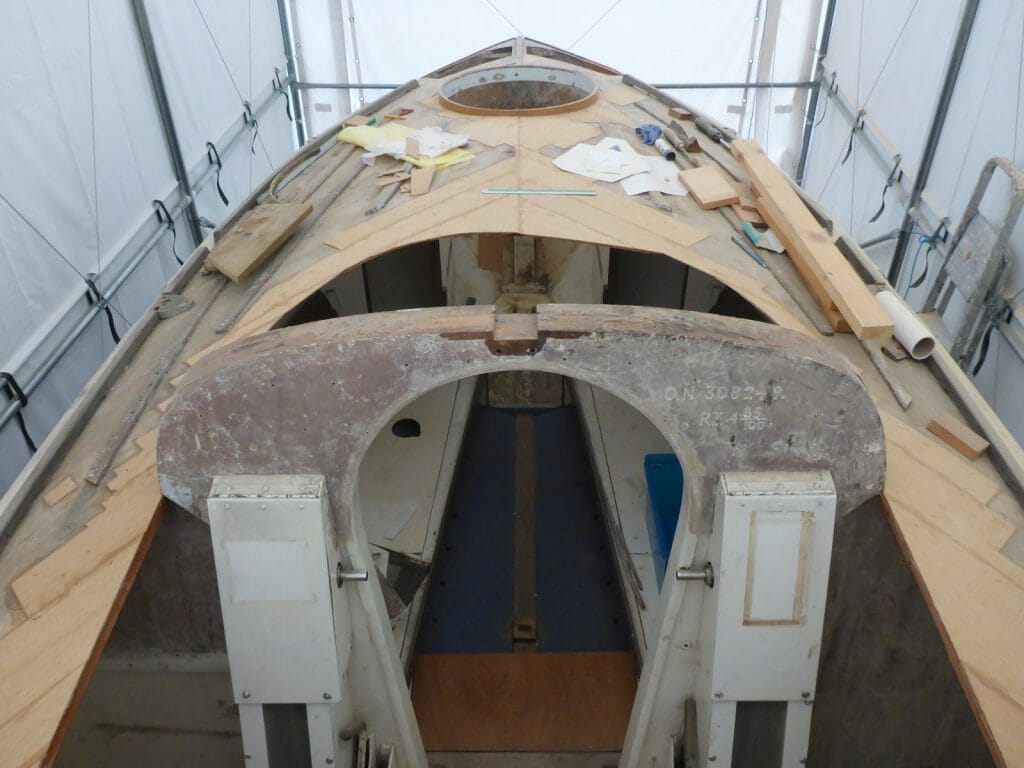The foredeck from the cockpit to the forehatch has now been repaired and just needs fairing and some longitudinal slats replacing.
The top laminate repairs on the bubble have now been faired and a start made to placing an additional lamination on top of it to replace thickness lost due to sanding in the past sometime. The chevrons now go the wrong way, but since I am proposing to paint it again, this will not matter.




Jonathan,
PSA photo of A89’s blister & deck support. Keep up the good work.
Simon and David,
Making a beefier “quarter round” is not a bad idea, and you are right, now is the time to do it. I am trying to avoid adding too much additional topside weight, which the additional skin on the blister has already done, but also stiffened it up quite a bit (see photograph). It should now have a minimum thickness of around 9mm and in places will be 11 mm or so.
Regarding the boat tent, I purchased a Boat Shelter Pro XL from Dancover. The size was partially dictated by the space available on the East side of my house, it is 3.5 m wide x 10 m long x 3.3 – 3.49 m high. It would have benefited from an extra half m of width, but I can prop a ladder all around it, but only just at the widest point. It is just long enough to take the boat on her trailer.
The cover is PVC, one piece for the top and sides, and the two ends. I erected the frame easily enough, but needed a couple of blokes to help me pull the PVC cover over the top. When delivered it did not have quite the right number of bolts for the frame, but Dancover supplied the missing bolts quickly. The wire and turnbuckle cross bracings make the whole structure quite stiff, and being partially sheltered by the house and some trees I have not been worried by gales. I would worry about a heavy fall of snow, but these are becoming rarer than they used to be. We have had none since the tent was erected. Dancover do make a more substantial model where the frame is of scaffolding sized poles, which I considered, but I think I made the right choice for my location. However, for a more exposed location I might reconsider.
That is very helpful Jonathan, thank you
What a great job you are doing Jonathan – i notice that she is inside what looks like a storage tent. My plans for Johara A-148 are severely hit by Hebridean weather and I have been long looking for a storage tent that will withstand 70 knot winds, yours looks very substantial and I would much appreciate hearing your thoughts on this
Many thanks
David
you can always increase the size of the strip that joins the blister to the deck I did this on Diaphony and it has made a lot of difference to the stiffness of the deck
While the blister is off would be easy to get the shape .
This jig worked very well on the Hydroplane restoration I did last year.. Did exactly the same on A5 which was laminated Brazilian mahogany cut in to strips with epoxy brushed on between laminates.
Doug, Richard and Nick,
Thank you all for your encouragement. I does at times seem a never-ending job, but progress is being made and it will be good to get Bluster (rain)watertight again, and strong again.
Regarding the coachroof, with just the skin it does wobble around, but the two bulkheads and hatch runners give it its stiffness, together with all the curved surfaces. The forward part is one big dome and thus quite stiff, provided that it is supported by the deck. Without that support it is at risk of coming apart on the centreline, starting at the forward end. This had started to happen on Bluster, but I just glued it up again as the blister kingplank was still securely attached to the laminate shells along most of its length and taking it all apart would have created a lot more damage to be repaired.
I have seen at least one Atalanta 26 with a vertical support under the forward end of the blister where the deck king plank and the curved supports under the deck and the edge of the blister all meet, and are glued, but have no good joints. This appears to be a weak point, which rapidly becomes weaker if it flexes and water begins to get into the joint. The only athwartship member is the “quarter” round, itself laminated and again prone to delamination if water gets in. I plan to laminate the port and starboard under-deck supports as one piece to help support the deck at the front of the coachroof. I hope that this will help take my weight when I stand on the deck.
I am not sure how much the windows contribute to the strength of the coachroof, It would probably be stronger without them, but a bit dark!
Jonathan
Hi. What he said!
You really are making a great job of Bluster and thank you very much for the regular updates and photos. They are inspiring and will be of great use to the many who may undertake their own restorations in the future.
Interesting to note how the size of the blister windows on Bluster mean there is not much wood on the blister sides. I guess the frames must provide a lot of the strength when they are in?
Nick
Great work Jonathan. Interesting photo of a main bulkhead.
Jonathan, what a tour de force, and also an education for a relatively newcomer like me.